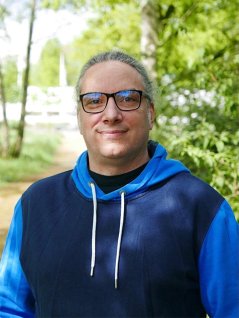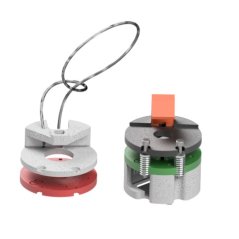
News
The open science story of Vittorio Saggiomo
In the series Open Science Stories, WUR researchers and teachers tell how they advance Open Science and Education at WUR. We interviewed Vittorio Saggiomo, assistant professor at the BioNanoTechnology Laboratory. He is a strong advocate and practitioner of open science hardware
What is open hardware in the world of science?
Open hardware follows design principles from the open technology movement, emphasizing transparency, collaboration, and accessibility. For open hardware in science, the design and specifications you use for your experiments are publicly available. Other researchers can build, customize and use the instruments for their experiments. So, not only the research findings and data are published, but also the blueprints, designs, drawings, specifications etc. for the tools are shared.
What sparked your interest in open hardware?

My main drive is that open hardware makes science (experiments) repeatable and the results reproducible. In my tenure track, I started to develop chemical sensors and devices to detect micro pollution in food and soil. The thing that annoyed me most was that I found publications that I could not repeat because the details of the used hardware were not shared. With open hardware, I can repeat experiments with exactly the same instruments, which makes the science more reliable.
Are there other advantages to embracing open hardware in research?
Another benefit of open hardware and the open technology movement is the use of cost-effective and easily available materials. By doing so, you improve the affordability and accessibility of scientific tools.
The technological development in my field, and science in general, has been massive. The costs of doing science have risen accordingly. While publications and data are increasingly open and for anyone to read, repeating and reproducing research experiments has become increasingly difficult and only for the happy few, so to speak. In my field of research, a lot of money is spent on developing specific instruments. By sharing our designs and using affordable materials, we remove some of the financial barriers, and science becomes more inclusive and accessible.
Could you share some examples of open hardware that your group has developed?
In our research, we use microfluidic devices to filter microparticles, such as microplastics, microalgae, or parasite eggs from liquids. This filtering and detection of microparticles is usually done with advanced and expensive instruments. In one of our recent projects, we succeeded in developing open hardware microfluidics by using a 3D printer to print the necessary parts.
We also developed open hardware syringe pumps. These are used to drive the liquid into the microfluidics. All the designs are free; you can download the designs, programs, and manuals to build them. We also made sure that the materials you need are relatively cheap and accessible. In this case, you only need a 3D printer. For more information on this device, see this publication.

Together with the microfluidic device, we also developed a cheap portable, battery-operated, wifi microscope, the Matchboxscope. This has already been built and used multiple times, even before being published.
Another nice feature of open hardware is collaborating with other scientists to improve the original designs. I get a lot of energy from the enthusiastic reactions of other scientists. We help out researchers who contact us and want to modify the original design or use it for other applications. Once we publish it online, it’s not finished. It’s a living document.
What are other examples of open hardware projects?
At WUR, Johannes Hohlbein from the Biophysics Group (BIP) has developed a high-end single molecule microscope as an open hardware design. They’ve also managed to make this equipment more affordable.
Groups at TU Delft, TU Eindhoven and the University Utrecht are also engaged in open hardware. TU Delft has a lively open hardware community, with several projects in the open science programme. In Utrecht, there is a great infrastructure where students can learn about open hardware. With these three universities, we’re participating in the upcoming Open Science festival on 31 August in Rotterdam. We’ll showcase several open hardware projects.
What tips do you have for researchers to become involved?
Well, first of all, you can subscribe to the Open Science Community Wageningen (OSC-W), and stay updated on the latest Open Science and Open Hardware news, meetings, and lunch seminars. Then, even before starting a project, think about who’s going to replicate it or use it. Sometimes we tend to overcomplicate projects to make them look fancy. A simpler project will have way more chances to be replicated and used. And my last tip is simple: documentation, documentation, documentation!! Any research is useless if it cannot be replicated.
What are your plans for the future?
Everything starts with teaching. We have to train our students, the scientists of the future, in open science and open hardware practices. I’d like to embed the open hardware concepts and techniques in the WUR educational programmes and curriculum. A new learning facility and curriculum for making scientific instruments are high on my wish list. It’d be nice to have a room with laser cutters, 3d printers, CNCs, etc. where students from different study programmes can use and experiment with molecular life sciences, plant, biotechnology, and farming technology.
I’m planning to develop a minor in open hardware and DIY science that will focus on 3D design and programming for scientific applications. I’m also planning to develop a VLAG course on open hardware for PhD students.
What can WUR do to support you more?
Well, that’s easy. The traditional system for evaluating scientists is not working anymore. Currently, you’re mainly judged on your publications. In my case, we’ve spent a lot of time putting all the blueprints online and making step-by-step guidelines so people can reproduce them. That's value creation pur sang. But in the current assessment system, that open science effort is not rewarded.
So, I hope that the Recognition and Reward change will come about soon and that the promotion and tenure systems at our university will become more personalized. We need a more personal and flexible approach to research assessment and career paths. Evaluation should also consider open science efforts, societal impact, and collaboration skills.